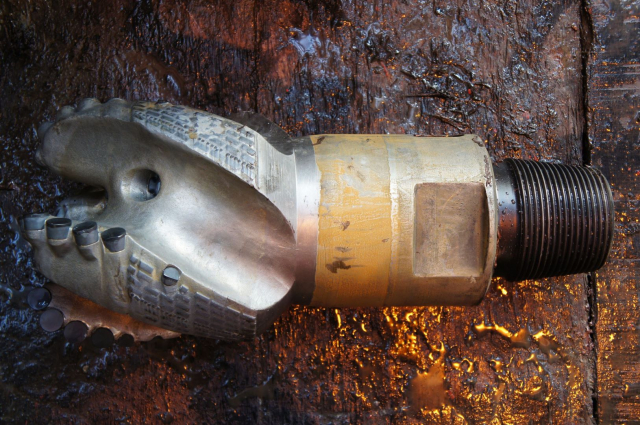Shale gas extraction technology
2015-01-07The term "shale gas" means natural gas located in rocks (slates) which is "trapped" in them, which prevents its extraction using typical methods for a normally spread resource of this type around the world (which have been widely exploited for many decades) Reaching shale gas and its extraction was made possible by using and developing well-known technologies of horizontal drilling and hydraulic fracturing.

This study presents
basic information on the methods of shale gas extraction. It is only an
introduction to further research conducted by the readers interested in this
topic, i.e. in advanced geological or technological publications. It is
considered as an "essence" of the topic for the reader not
professionally involved in the said issues.
For many years the
extraction industry has been aware of the occurrence of so-called
unconventional resources of different types, including hydrocarbons such as oil
or natural gas. Slates as a place where the deposits are located are simply
unconventional resources. The barrier for its wide exploitation was the lack of
appropriate technology. At around the beginning of this century the extraction
of natural gas from slates began. The United States is the leading country in
shale gas extraction as the demand for unconventional resources grows. Many
people even started talking about the "slate revolution" (it is
contributing to a change in the trends of traditional rules of the global
energy resource market. The USA, as the biggest importer of oil, is supposed to
be resource independent in the next few years and can even become an exporter,
which poses a great challenge for the current suppliers of energy for the
United States.
After estimating that a
given area is rich in shale gas and after conducting preparatory work (i.e.
adapting the terrain to the planned drills or bringing equipment and worker
teams) a vertical drill commences. When the drilling reaches the rocks rich in
the resource the horizontal drilling commences (side drilling - is essential in
the case of slates in order to release the gas; it is different in the case of
natural gas where the vertical drill is sufficient and there are no additional
"barriers" which have to be broken in order to get to the gas). A
pipe is inserted into the bore hole which separates it from the surroundings
and functions as a safety precaution. The bore hole is sealed up with cement.
Next, a device called a "perforation cannon" is inserted into the
horizontal bore hole which is supposed to drill small openings in the pipe
which transport the accumulated gas into the bore hole and then up to the
surface (the cannon is supplied with explosives which create the openings). The
bore hole is filled with fracturing liquid under high pressure. Its role is to
further increase the rock flow, expand the created cracks (spaces) and create
new ones which in turn increases the release rate of the gas into the bore
hole. When this process is finished the gas can be extracted from the
unconventional deposit. Due to the infrastructure on the surface of the bore hole
the material is stored and infused into to the gas pipeline which transports it
to the recipients (companies, private persons, etc.).
The fracturing liquid is
mostly water and sand. The sand is supposed to get into the cracks created in
the slate rock and prevent them from closing up, which would make it impossible
for the gas to be released. Apart from that, the liquid contains chemicals
which help to create the cracks during the fracturing process and destroys any
bacteria in the rock. These chemicals
are salt acid, glutaric aldehyde or formamide.
At
the end of 2012 the media spread the news about the developed Polish technology
of hydraulic fracturing which uses CO2 instead of liquid - first in liquid form
which then (in the bore hole) transforms into gas. CO2 is supposed to push out
the natural gas from the cracks and allow it to move up to the surface through
the bore hole.
Between 2012 and 2011
the American oil company Schlumberger started extraction work using the newly
developed Hiway method. It is slightly different from the "classic"
hydraulic fracturing. The fracturing liquid is not poured only once but several
times (pulsating injection) which creates a larger number of deep reaching
cracks. Apart from the fracturing liquid the bore hole is injected with
dissolving fibres alternately which increase work efficiency.
The other important
matter connected with natural resource extraction is the estimate of a given
deposit. The most common used method is the Petroleum Resources Management
System (PRMS). It was announced in 2007 and is a result of the work conducted
by several international organizations from the drilling sector. This method
uses data such as deposit volume, rock permeability, layer thickness with
organic substances above 2% and the level of maturity of this substance. A
different approach can also be used such as the probabilistic method which
includes approaches other than strictly geological1.
Shale gas extraction or more widely known as "unconventional" gas will always be connected with costs of necessary works. If reaching the resource is not profitable it will be abandoned. Technological progress will be the key factor in such cases. On using individual methods in determining Poland's abundance in shale gas look at: http://www.kngpan.agh.edu.pl/wp-content/uploads/OPINIA-KNG-PAN-w-sprawie-gazu-%C5%82upkowego-stanowisko-oficjalne.pdf, obtained on. 30 January 2013

